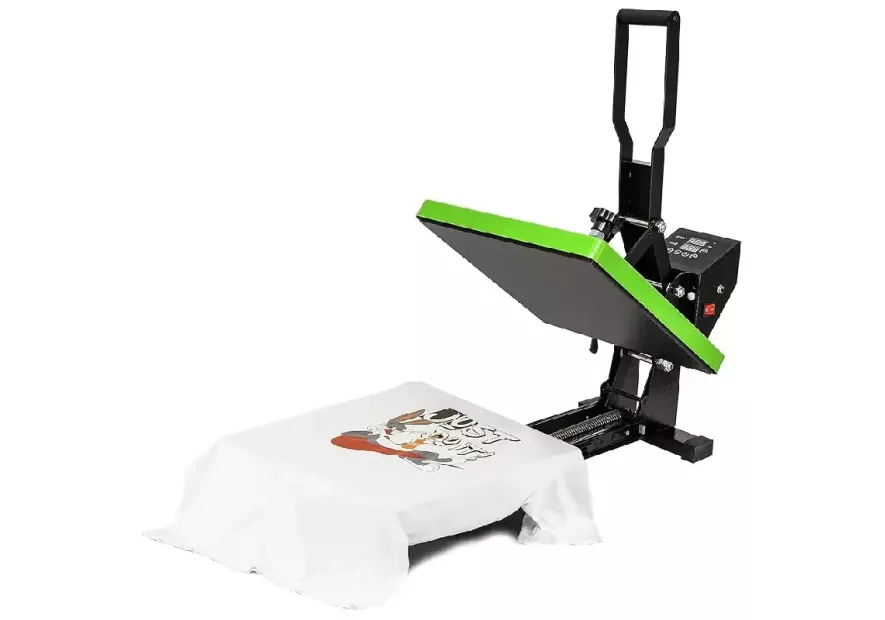How does heat press machine work?

In the customization business, heat presses have become a preferred alternative to home irons because of their ability to provide uniform pressure and consistent temperature, key factors in achieving professional results. Heat presses can work with different materials and types of transfers, making them a versatile tool for both beginners and experts in creating customized products. Heat presses are popular with crafters and small businesses looking to customize products because they simplify the process and deliver consistent results.
What is a heat press?
A heat press is an essential tool for product customization, allowing you to transfer designs quickly and efficiently to a variety of surfaces. Through the use of heat and pressure, heat transfer vinyl, sublimation printing, DTF printing, DTV printing and other printing techniques can be applied to objects such as T-shirts, tote bags, pillowcases and more. This process ensures that designs adhere permanently, creating high quality and durable products.
How does it work?
Its operation is based on the application of heat and pressure on a material for a given time, which allows images, designs or graphics to be transferred to a surface. This process is key to ensuring that the design is adhered durably and in high quality to the chosen object.
The heat press consists of two main plates:
- Upper plate: is responsible for generating the heat. It can reach temperatures up to 400 degrees Fahrenheit, depending on the type of material being used.
- Bottom plate: is where the substrate is placed, such as a T-shirt, bag or other flat object. Although this plate does not generate heat by itself, it is heated during the pressing process.
To use a heat press, a basic process is followed
- Preparation: The temperature and time are set according to the type of material and design to be transferred. Each material, whether it is heat transfer vinyl, sublimation paper or DTF prints, has its own temperature and time requirements.
- Placement: You place the material on the bottom plate and make sure it is positioned properly. Then, the design or transfer is placed on top of the material.
- Heat and pressure application: The top plate is lowered, applying heat and pressure evenly over the design and material. The pressing time will depend on the specifications of the material used.
- Completion: Once the timer is turned off, the press opens and the transferred design is allowed to cool before the transfer paper is removed, depending on the type of material, either hot or cold. The success of the process depends on the correct setting of temperature, time and pressure, which vary depending on the type of material and design being used. It is important to follow the manufacturer's recommendations for best results.
Types of heat presses: Clamshell vs. side opening
There are two main types of heat presses on the market, each with particular characteristics to suit different customization needs: clam type presses and side-opening presses.
Clam type presses
Clam-type heat presses are characterized by opening and closing like a clamshell. The top plate is attached to a hinge at the rear of the machine, allowing it to be raised and lowered directly onto the material to be pressed. This is one of the most popular options due to their compact design, making them ideal for small spaces or when looking for a tool that does not take up too much side space.
Advantages:
- Takes up less horizontal space, as the opening is upwards.
- It is a more economical option, so it is popular with crafters and beginners.
Disadvantages:
- Can be more difficult to position material correctly, as the hot top plate is very close to the work surface, increasing the risk of burns.
- Not the best choice for thick objects, as the pressure is applied at an angle, which could displace the object.
Side-opening press
Side-opening heat presses, also known as "swing-away" presses, have a top plate that lifts up and then slides to the side. This means that the top plate is never directly over the work area when you're setting or adjusting material, which makes operation easier and reduces the risk of burns.
Advantages:
- Provides greater working space, as the top plate moves completely out of the work area, facilitating precise placement of material.
- It is ideal for working with thicker objects, such as wooden signs, as pressure is applied evenly from above.
Disadvantages:
- Requires more lateral space to allow movement of the top plate.
- Generally, they are more expensive than clamshell presses.
Which one to choose?
The choice between a clamshell or side-opening press will depend on your specific needs. If you have limited work space and work primarily with thin, flat items, a clamshell press may be the best choice for you. However, if you need to work with thicker materials or prefer to have more room to adjust the material, a side-opening press will provide greater comfort and safety.
Parts of a heat press
A heat press is composed of several essential parts that work together to properly apply the heat and pressure necessary to transfer designs to various types of surfaces.
The main parts of a heat press are described below:
Top plate or heating plate 2
- The top plate is the most important part of the heat press, as it is responsible for generating the heat necessary for the transfer process.
- This plate can reach temperatures of up to 400 degrees Fahrenheit, depending on the type of material being processed.
- It is made of metal and contains heating elements that distribute the heat evenly over the material to be pressed.
- It is essential not to touch this plate during operation, as it can cause severe burns.
Bottom plate
- The bottom plate is the base where the object or material to be customized is placed.
- Although this plate does not generate heat by itself, it is heated during the process by being in contact with the upper plate.
- It is usually made of aluminum and is covered by a rubber or foam pad to protect the material and ensure uniform pressure.
Pressing pad
- The pressing pad is located on the bottom plate and is made of heat-resistant rubber or foam.
- Its function is to provide a slight "cushioning" to the pressing process, which helps to ensure that the material is pressed tightly between the two plates without damage.
- This pad allows objects to be held in place during transfer.
Pressure adjustment knob
- The pressure knob allows you to adjust the amount of pressure applied to the material.
- Depending on the type of transfer and substrate being used, light, medium or heavy pressure may be required.
- The knob is usually located on the top of the machine, and can be turned to increase or decrease the pressure according to the needs of the project.
Opening handle or lever
- The handle or lever is what is used to open and close the heat press.
- In a clamshell press, the lever opens the top plate upward, while in a side-opening press, the handle allows the top plate to be moved to the side.
- This handle is also used to ensure that the press is completely closed during the transfer process, applying the necessary pressure.
Control Panel
- The control panel is where the temperature and time settings are configured.
- Depending on the press model, the control panel may offer additional options, such as switching between Fahrenheit and Celsius.
- On this panel, you can also set the pressing duration, which ensures that heat is applied for the exact time needed for optimal results.
- Some more advanced presses also allow the machine to be calibrated to more accurately adjust the temperature and pressure.
Metallic base
- The entire structure of the heat press rests on a heavy metal base, which gives it stability during use.
- This base ensures that the press does not slip or move while applying heat and pressure, which is crucial to avoid accidents and ensure uniform transfer.
- Some bases have suction feet for added stability.
Temperature and pressure settings on a heat press.
The correct setting of temperature, time and pressure is critical to achieving successful transfer in a heat press. Each material type and transfer technique have specific requirements that must be followed for optimal results. The key aspects of each of these factors are detailed below.
Temperature
Temperature is a critical factor in the transfer process. Depending on the type of material being used, the temperature required can vary considerably. For example:
- For heat transfer vinyl, the temperature is typically between 305 and 320 degrees Fahrenheit (approximately 150 to 160 degrees Celsius).








Leave a comment